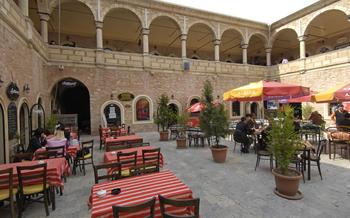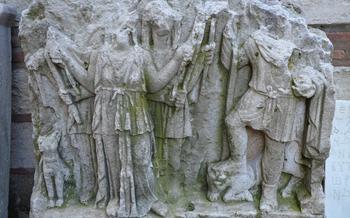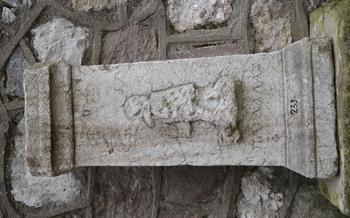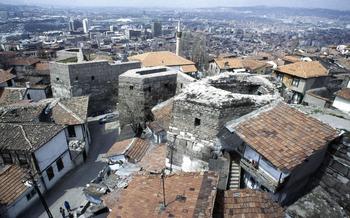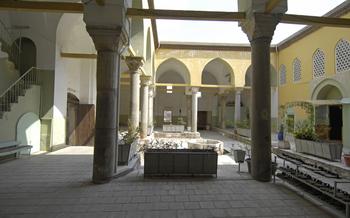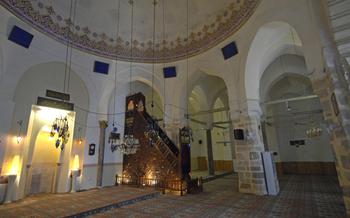
The Stone Inn (Tas Han) of Manisa
- A Journey to the Past: Exploring the Stone Inn
- Beyond Walls: The Han as a Social Center
- A Bazaar of Delights: Unveiling the Market
- Caravanserai Architecture: A Closer Look
- A Retreat for weary Travelers
- A Culinary Adventure: Delights from the Han
- Unveiling the Han's Secrets: A Guided Tour
- A Sanctuary in Time: The Han's Resilience
- The Stone Inn's Legacy: A Symbol of Endurance
- A Haven for History and Culture Enthusiasts
- The Han's Environs: Exploring Nearby Sites
- A Stroll Through History: The Han's Surroundings
- Capturing the Essence: Photography at the Han
- Insider Tip: Unveiling Local Secrets
A Journey to the Past: Exploring the Stone Inn
Nestled in the heart of Manisa, Turkey, the Stone Inn, also known as Tas Han, stands as a testament to the city's rich history and architectural heritage. Built in the 14th century during the Anatolian Beyliks period, the han has witnessed centuries of trade, cultural exchange, and social gatherings. Its imposing stone structure and intricate carvings transport visitors back in time, offering a glimpse into the vibrant past of this ancient land.
The han's history is deeply intertwined with the rise and fall of various empires that ruled over Anatolia. Initially constructed as a caravanserai, it served as a crucial resting point for weary travelers and merchants traversing the Silk Road. The han's strategic location along trade routes made it a bustling hub of commerce and cultural exchange, where goods from distant lands were exchanged, and ideas and traditions intermingled.
As centuries passed, the han underwent several renovations and modifications, reflecting the changing needs and tastes of its successive occupants. Despite these transformations, the han's original architectural features remain largely intact, preserving its historical integrity and showcasing the remarkable craftsmanship of its builders.
Beyond Walls: The Han as a Social Center
The Stone Inn, known as Tas Han in Turkish, served as more than just a resting place for weary travelers. It played a pivotal role as a vibrant social center, fostering interactions and fostering a sense of community. In its heyday, the Han bustled with activity as merchants, travelers, and locals converged to exchange not only goods but also ideas, stories, and cultures.
The Han's courtyard, with its serene ambiance and sheltered from the elements, provided an ideal setting for social gatherings. Here, people from diverse backgrounds came together to engage in lively conversations, share tales of their journeys, and forge new connections. The marketplace within the Han further contributed to its social significance, as people haggled over prices, exchanged local gossip, and built relationships that extended beyond mere transactions.
Throughout history, the Stone Inn has borne witness to countless social interactions, from intimate conversations between friends to lively debates on politics, philosophy, and religion. It served as a melting pot of cultures, where people from different regions and ethnicities came together, fostering a spirit of tolerance and understanding. Even today, the Han retains its social significance, attracting visitors from far and wide who seek to immerse themselves in the rich history and vibrant atmosphere of this remarkable place.
A Bazaar of Delights: Unveiling the Market
The Stone Inn's market is a bustling hub of activity, where the air is filled with the scent of spices and the sound of haggling merchants. Here, visitors can immerse themselves in the vibrant tapestry of Turkish trade, where local artisans showcase their exquisite creations. From intricate carpets to gleaming copperware, the market offers an array of products that reflect the region's rich cultural heritage.
Handcrafted carpets, adorned with vibrant patterns and intricate designs, are a testament to the skill and artistry of local weavers. Visitors can marvel at the vibrant colors and intricate motifs that adorn these beautiful creations. The market also boasts a dazzling array of copperware, from gleaming pots and pans to decorative ornaments, each piece showcasing the exceptional craftsmanship of Turkish artisans.
In addition to these traditional items, the market also offers a plethora of other treasures. Visitors can find an assortment of spices, from the pungent aroma of cumin to the sweet fragrance of cinnamon. Dried fruits, nuts, and delectable Turkish delights provide a sweet treat for those with a sweet tooth. The market is a true feast for the senses, where visitors can immerse themselves in the vibrant atmosphere and discover the essence of Turkish trade.
Caravanserai Architecture: A Closer Look
The Stone Inn, like many other caravanserais in Turkey, showcases remarkable architectural features that reflect the ingenuity and practicality of its design. The courtyard, the heart of the Han, serves as a central gathering space, providing shelter from the elements and fostering a sense of community among travelers. Surrounding the courtyard are rooms and stables, carefully arranged to optimize space and ensure the comfort of guests and their animals.
The caravanserai's layout is a testament to the architects' understanding of functionality and aesthetics. The entrance gate, often adorned with intricate carvings, leads to the courtyard, creating a sense of grandeur and welcoming weary travelers. The rooms, typically located on the upper floors, offer privacy and comfort, while the stables on the ground floor provide secure shelter for animals.
The architectural details of the Stone Inn are not merely decorative; they also hold symbolic significance. The arches, domes, and vaults that grace the building's facade represent the fusion of Islamic and Byzantine architectural traditions. The intricate stone carvings and geometric patterns symbolize protection and good fortune, reflecting the beliefs and aspirations of the people who built and used the Han.
A Retreat for weary Travelers
The Inn's Original Purpose
The Stone Inn of Manisa, or Tas Han, was primarily conceived as a caravanserai, serving as a haven for weary travelers traversing the ancient trade routes. It offered a sanctuary for merchants, pilgrims, and travelers seeking respite from their journeys. The han's strategic location along the Silk Road made it a bustling hub for trade and a vital stopover for those venturing across the region.
Accommodation Facilities
The inn's architectural design reflected its primary function, featuring a central courtyard surrounded by guest rooms and stables. The courtyard provided a communal space for travelers to gather, exchange stories, and share meals, fostering a sense of camaraderie and community. The guest rooms, though modest in size, offered a basic level of comfort and privacy for weary travelers seeking a place to rest and recharge before continuing their journeys.
Hospitality in the Han
The Stone Inn was renowned for its warm hospitality, reflecting the deeply ingrained Turkish tradition of welcoming guests with open arms. The innkeepers and staff went above and beyond to ensure that travelers felt comfortable and well-cared for during their stay. They provided assistance with finding suitable lodgings, arranging transportation, and recommending local attractions. The han's reputation for hospitality contributed to its popularity among travelers, making it a preferred stopover for those seeking a welcoming and restful haven along their journeys.
A Culinary Adventure: Delights from the Han
The Stone Inn, also known as Tas Han, is not only a historical landmark but also a culinary paradise. Visitors can embark on a gastronomic journey, savoring the flavors and aromas of traditional Turkish cuisine. Within the Han's charming courtyard, travelers can find an array of restaurants and cafes offering a delightful selection of local specialties.
From the moment you step inside, the air is filled with the enticing scents of freshly baked bread, grilled kebabs, and aromatic spices. Indulge in the mouthwatering flavors of lahmacun, a crispy flatbread topped with minced meat and vegetables, or savor the succulent köfte, grilled meatballs served with rice and tangy tomato sauce.
One of the must-try dishes at the Stone Inn is Manisa kebabı, a local delicacy made with tender lamb meat marinated in yogurt and spices, then grilled to perfection. Served with grilled vegetables and a drizzle of zesty lemon sauce, this dish is a true delight for the senses.
For those who prefer vegetarian options, there are plenty of tempting choices to satisfy your cravings. Sample the imam bayıldı, a flavorful dish made with roasted eggplants stuffed with a mixture of onions, garlic, tomatoes, and herbs, or try the kısır, a bulgur salad with fresh vegetables, herbs, and a tangy dressing.
No meal at the Stone Inn would be complete without a taste of Turkish coffee, renowned for its strong and rich flavor. Sip on a cup of this invigorating beverage while enjoying the lively atmosphere of the Han, surrounded by the sounds of conversations, laughter, and the clinking of dishes.
Whether you're seeking a quick bite or a leisurely dining experience, the Stone Inn offers a culinary adventure like no other. Immerse yourself in the flavors and aromas of Turkish cuisine, and let your taste buds dance with delight as you explore the culinary treasures of this historic landmark.
Unveiling the Han's Secrets: A Guided Tour
The Stone Inn offers guided tours that provide an invaluable opportunity to delve into the depths of its history and significance. Led by knowledgeable local experts, these tours offer a rich tapestry of historical insights and anecdotes that bring the Han's past to life. Expert guides unveil the hidden stories and secrets that lie within the Han's walls, shedding light on its construction, its role in trade and travel, and its enduring legacy as a cultural and historical landmark.
Joining a guided tour at the Stone Inn is an enriching experience that allows visitors to discover the Han's intricate details, architectural nuances, and cultural significance. Guides provide a comprehensive overview of the Han's history, from its origins as a caravanserai to its transformation into a vibrant marketplace and social hub. They also delve into the architectural features that make the Han unique, such as its stunning courtyard, intricate stonework, and ornamental motifs.
For those seeking a deeper understanding of Turkish history and culture, a guided tour of the Stone Inn is an essential experience. Expert guides offer a wealth of knowledge and insights that illuminate the Han's role in shaping the region's rich heritage. They provide context to the Han's significance as a symbol of endurance and resilience, showcasing its ability to withstand the test of time and emerge as a testament to Turkey's enduring cultural legacy.
A Sanctuary in Time: The Han's Resilience
Despite enduring centuries of wear and tear, the Stone Inn of Manisa stands as a testament to its enduring strength. Its walls bear the weight of time, yet its foundations remain as sturdy as ever. Over the years, the han has undergone several restoration efforts aimed at preserving its historical essence while ensuring its continued functionality. These efforts have been meticulously carried out, respecting the original design and materials used in its construction. As a result, the Stone Inn continues to serve as a vibrant hub of activity, preserving a legacy that spans generations. It stands as a reminder of the enduring spirit of the Turkish people and their unwavering commitment to preserving their cultural heritage.
The Stone Inn's Legacy: A Symbol of Endurance
The Stone Inn of Manisa stands as a testament to the enduring spirit of Turkish history and culture. Having weathered the storms of time, it now serves as a symbol of the nation's resilience and cultural heritage. The Han's longevity, coupled with its remarkable architectural features, has earned it a place of honor among Turkey's most cherished landmarks.
As a living embodiment of Turkish craftsmanship and architectural prowess, the Stone Inn reflects the skill and dedication of its creators. Its intricate stonework, ornamental motifs, and harmonious layout continue to inspire awe and admiration in visitors from around the world. Beyond its aesthetic appeal, the Han holds immense historical significance, having served as a vital hub of commerce and cultural exchange for centuries.
Today, the Stone Inn stands as a symbol of Turkey's commitment to preserving its rich heritage. Through meticulous restoration efforts, the government has ensured that this architectural gem continues to shine as a beacon of Turkish culture. The Han's enduring legacy serves as a reminder of the nation's deep-rooted traditions and its unwavering dedication to safeguarding its cultural treasures.
A Haven for History and Culture Enthusiasts
The Stone Inn, with its captivating history and architectural grandeur, serves as a haven for enthusiasts of history and culture, inviting them to unravel its stories and immerse themselves in Turkey's rich heritage. This ancient edifice offers a glimpse into the past, shedding light on the nation's traditions, customs, and artistic achievements. Within the Han's walls, visitors can embark on a journey through time, discovering the tales of weary travelers, bustling trade, and vibrant community gatherings that once filled its spaces.
The Stone Inn stands as a living testament to Turkey's historical significance, a symbol of its resilience and cultural diversity. Its intricate architecture, ornamental motifs, and serene courtyard provide a backdrop for visitors to explore the nation's past and delve into its cultural tapestry. Whether you're a seasoned history buff or simply someone with a keen interest in diverse cultures, the Stone Inn offers an unforgettable experience, allowing you to connect with the spirit of Turkey and gain a deeper understanding of its heritage.
The Han's Environs: Exploring Nearby Sites
The Stone Inn stands as a testament to Manisa's rich history, but it is far from the only attraction in this vibrant city. A short stroll from the Han leads to the Mosque of Sultan Mehmed, an architectural marvel that showcases the grandeur of Ottoman architecture. The mosque, with its intricate tilework and soaring minarets, invites visitors to step back in time and immerse themselves in the city's Islamic heritage.
Adjacent to the mosque lies the Mausoleum of Sultan Mehmed, the final resting place of the revered Ottoman ruler. The mausoleum, with its elegant dome and ornate carvings, exudes an aura of serenity and pays homage to the sultan's legacy.
For those seeking a deeper understanding of Manisa's past, the Manisa Museum beckons with its collection of archaeological artifacts, historical documents, and ethnographic exhibits. The museum offers a comprehensive journey through the city's history, from its ancient roots to its modern-day transformation.
These nearby sites, each with its unique story to tell, complement the experience of visiting the Stone Inn, painting a vivid picture of Manisa's rich cultural tapestry.
A Stroll Through History: The Han's Surroundings
Venturing beyond the Stone Inn (Tas Han) reveals the captivating tapestry of history that Manisa proudly displays. The old city, with its labyrinthine streets and charming Ottoman architecture, beckons visitors to embark on a journey through time. The Manisa Fortress, a majestic symbol of resilience, stands as a testament to the city's rich military heritage. Its imposing walls and strategic location offer breathtaking views of the surrounding landscape. As you wander through these historic quarters, you can almost hear the echoes of past civilizations, their stories woven into the very fabric of the city. Prepare to be captivated as you immerse yourself in the vibrant aura of Manisa's storied past.
Capturing the Essence: Photography at the Han
The Stone Inn, with its captivating blend of history and aesthetics, makes for a photographer's paradise. The intricate stonework, the serene courtyard, and the ornamental motifs provide ample opportunities to capture stunning shots.
To make the most of your photography experience at the Han, consider the following tips:
-
Golden Hour Magic: Plan your visit during the golden hours of sunrise and sunset to capture the warm, diffused light that enhances the Han's beauty.
-
Experiment with Perspectives: Don't just stick to standard shots; try different angles and perspectives to create unique and eye-catching compositions.
-
Details Matter: Zoom in on the intricate details of the Han's architecture, such as the carvings on the stonework or the patterns in the tiles.
-
Play with Light and Shadow: The Han's courtyard offers beautiful play of light and shadow, especially during the late afternoon. Use this to your advantage to create dramatic and atmospheric shots.
-
Capture the Spirit: Beyond the architectural beauty, try to capture the essence of the Han by photographing people interacting with the space, whether it's a local artisan working at their craft or a group of friends enjoying a meal in the courtyard.
Insider Tip: Unveiling Local Secrets
To truly immerse yourself in the essence of Manisa, venture beyond the confines of the Stone Inn and explore the city's hidden gems. Stroll through the vibrant local markets, where you'll find an array of fresh produce, handmade crafts, and traditional Turkish delights. Engage with the friendly locals, who will gladly share stories and insights into their culture and way of life.
Seek out the lesser-known historical sites, such as the charming old churches and mosques tucked away in quiet corners of the city. Immerse yourself in the beauty of the surrounding natural landscapes by embarking on a scenic hike or bike ride through the picturesque countryside.
For a truly authentic experience, indulge in the local cuisine at one of the many traditional Turkish restaurants in Manisa. Savor the flavors of freshly grilled meats, aromatic stews, and delectable desserts, all prepared with love and passion.
Manisa is a city waiting to be explored, revealing its secrets to those who seek them. Embrace the opportunity to connect with the locals, discover hidden treasures, and create lasting memories that will forever remind you of your time in this enchanting city.
